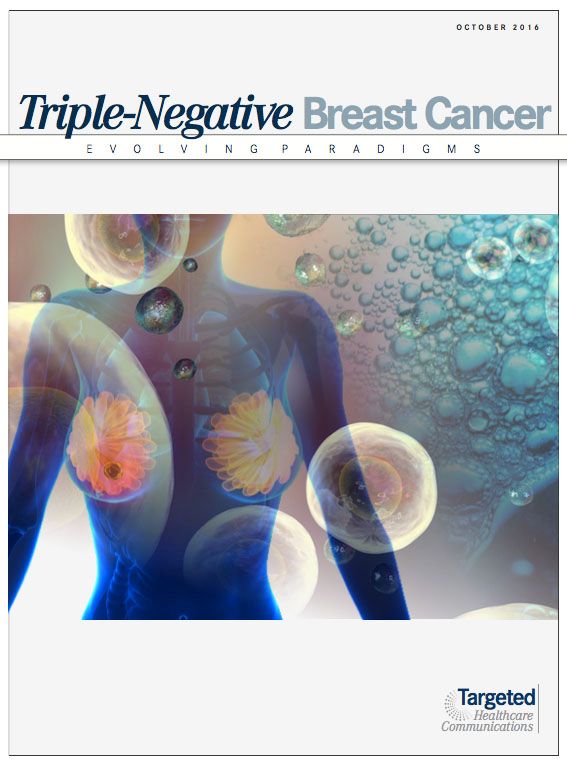Future of TNBC Research and Treatment: A Movement Toward Precision Medicine
While TNBC is a heterogeneous group of breast cancers there is increasing effort to subdivide it into more homogenous groups that may help in more accurate prognosis and response to therapy.
This article is part I of a series. View parts II and III:Evolving Paradigms in Triple-Negative Breast Cancer> >
While TNBC is a heterogeneous group of breast cancers there is increasing effort to subdivide it into more homogenous groups that may help in more accurate prognosis and response to therapy.
Le Du et al propose that five molecular subtypes of TNBC have a high potential to drive clinical trials. These include the basal-like, mesenchymal-like, the immune-associated, androgen receptor overexpression in the luminal/apocrine group, and HER2-enriched.80
Because of genetic instability of the tumors, the cancer can have molecular changes throughout the course of the disease. Therefore, it is not known if molecular classification at the time of diagnosis will continue to be predictive of response after treatment as the tumor evolves. Less invasive methods, such as analysis of circulating tumor DNA or circulating tumor cells, may be an accurate method of monitoring clinical response to treatment and personalizing the treatment as the disease progresses. As more research continues into the molecular subtypes of TNBC, there is the potential to uncover additional biomarkers (FIGURE 5).80
Figure 5. Triple-Negative Breast Cancer classifications.
An additional target under research in the treatment of TNBC is the notch signaling pathway, which is involved in self-renewal, angiogenesis, proliferation, and apoptosis. TNBC xenograft models with NOTCH1 rearrangements were found to be sensitive to gamma-secretase inhibitors.81
PF-03084014 is a selective gamma-secretase inhibitor that is thought to have antitumor activity by blocking activation of notch receptors.82A phase II, open-label biomarker study of PF- 030804014 is under way for nonmetastatic chemoresistant TNBC (NCT02338531).83
There is evidence that the JAK2/STAT3 pathway disruption may be a potential target in TNBC. Janus kinases (JAKs) are another group of tyrosine kinases involved in cell survival and growth. In basal-like breast cancer, JAK/STAT3 was found to be active and inhibition led to decreased growth in the xenograft models.81
Ruxolitinib, an IL-6/JAK/STAT inhibitor, is being studied in a phase I trial for recurrent breast cancer, with a phase II portion specifically for preoperative inflammatory TNBC (NCT02041429).84
Trop-2 is overexpressed in some epithelial cancers and involved in cell-to-cell adhesion. The US Food and Drug Administration (FDA) gave a fast track designation to IMMU-132 (isactuzumab govitecan) for progressive metastatic TNBC.81An open-label, phase II study that is not yet recruiting will look at IMMU-132 and carboplatin in patients with TNBC (NCT02161679).85
Innate immunosurveillance has the ability to identify cancerous cells and destroy them. However, cancer cells characteristically have the ability to evade the immune system. New evidence points to cytotoxic T-lymphocyte antigen (CTLA) inhibitors and programed cell death-1 inhibitors (PD-1) as potential targeted immunotherapies. Furthermore, the PD-1 ligand, PD-L1, is expressed in about 20% of TNBC and confers a poorer prognosis.86Nanda et al presented an abstract for pembrolizumab (MK-3475), a selective humanized monoclonal antibody that blocks PD-1, in the treatment of advanced TNBC. They found that pembrolizumab was tolerated and effective in heavily pretreated TNBC and thus opens the door for immune checkpoint inhibition in TNBC.87
New research into the association of CD44(+)/CD24(-) and TNBC found this relationship may play a role in the aggressive nature of TNBC. Therefore, CD44(+)/CD24(-) may be another future targeted therapy in the TNBC population.88
Finally, new research into insulin-like growth factor may provide even more options for targeted therapy. For example, insulin-like growth factor-2 mRNA binding protein 3 (IMP3) is expressed in TNBC, and its function is not completely understood. Evidence now points to IMP3 being involved in breast tumor initiation and more aggressive diease.89Likewise, insulin-like growth factor binding protein-3 (IGFBP-3) is highly expressed in TNBC and may function as a tumor promotor. The mechanism involves interaction with EGFR and growth-stimulatory signaling. Furthermore, the interaction of IGFBP-3 and EGFR may be asscoiated with TNBC chemoresistance. In-depth understanding of this relationship is another potential target for TNBC treatment.90
Click here for references:Evolving Paradigms in Triple-Negative Breast Cancer: References> >
